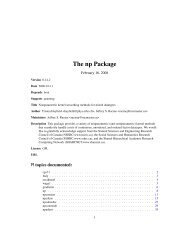The gstat Package - NexTag Supports Open Source Initiatives
The gstat Package - NexTag Supports Open Source Initiatives
The gstat Package - NexTag Supports Open Source Initiatives
Create successful ePaper yourself
Turn your PDF publications into a flip-book with our unique Google optimized e-Paper software.
fit.variogram 5fit.rangesfit.methoddebug.levelwarn.if.neglogical; determines whether the range coefficients (excluding that of the nuggetcomponent) should be fitted; or logical vector: determines for each range parameterwhether it should be fitted or fixed.fitting method, used by <strong>gstat</strong>. <strong>The</strong> default method uses weights N h /h 2 with N hthe number of point pairs and h the distance. This criterion is not supported bytheory, but by practice. For other values of fit.method, see table 4.2 in the<strong>gstat</strong> manual.integer; set <strong>gstat</strong> internal debug levellogical; if TRUE a warning is issued whenever a sill value of a direct variogrambecomes negativeValueNotereturns a fitted variogram model (of class variogram.model).This is a data.frame has two attributes: (i) singular a logical attribute that indicates whether thenon-linear fit converged, or ended in a singularity, and (ii) SSErr a numerical attribute with the(weighted) sum of squared errors of the fitted model. See Notes below.If fitting the range(s) is part of the job of this function, the results may well depend on the startingvalues, given in argument model. This is nothing new, but generally true for non-linear regressionproblems. This function uses the internal <strong>gstat</strong> (C) code, which interates over (a) a direct (leastsquares) fit of the partial sills and (b) an iterated search, using gradients, for the optimal rangevalue(s), until convergence of after a combined step ((a) and (b)) is reached.If for a direct (i.e. not a cross) variogram a sill parameter (partial sill or nugget) becomes negative,fit.variogram is called again with this parameter set to zero, and with a FALSE flag to further fit thissill. This implies that once at the search space boundary, a sill value does not never away from it.On singular model fits: If your variogram turns out to be a flat, horizontal or sloping line, then fittinga three parameter model such as the exponential or spherical with nugget is a bit heavy: there’s aninfinite number of possible combinations of sill and range (both very large) to fit to a sloping line. Inthis case, the returned, singular model may still be useful: just try and plot it. Gstat converges whenthe parameter values stabilize, and this may not be the case. Another case of singular model fitshappens when a model that reaches the sill (such as the spherical) is fit with a nugget, and the rangeparameter starts, or converges to a value smaller than the distance of the second sample variogramestimate. In this case, again, an infinite number of possibilities occur essentially for fitting a linethrough a single (first sample variogram) point. In both cases, fixing one or more of the variogrammodel parameters may help you out.Author(s)Edzer J. PebesmaReferenceshttp://www.<strong>gstat</strong>.org/Pebesma, E.J., 2004. Multivariable geostatistics in S: the <strong>gstat</strong> package. Computers & Geosciences,30: 683-691.
















